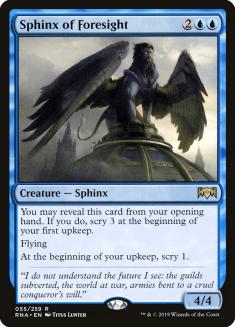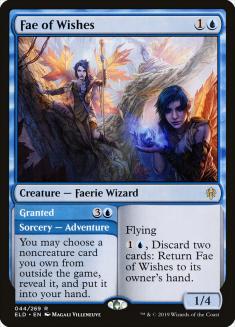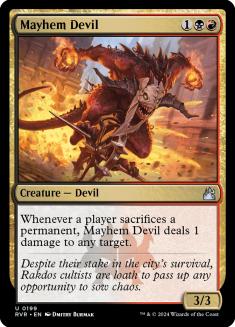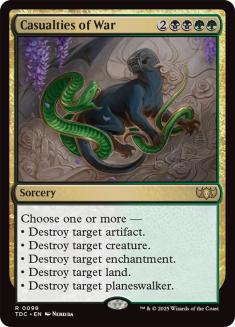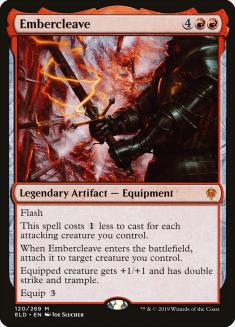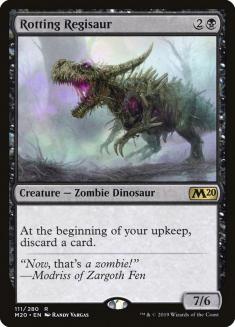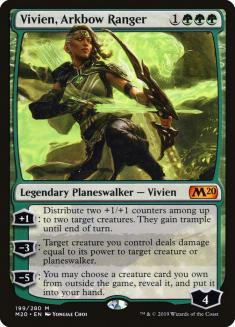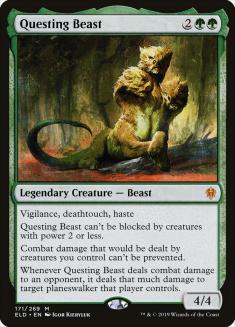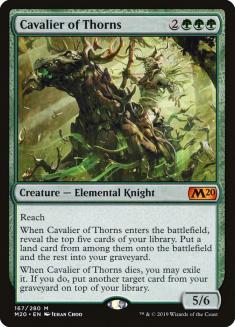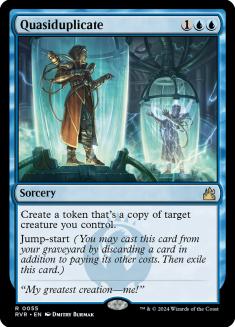With the Oko, Thief of Crowns ban, Throne of Eldraine Standard has opened up a lot, and I feel like there’s no clear best deck like there was with Bant Golos and then Simic/Sultai Food. This means I’ve been testing a lot of different decks in an attempt to find the one I like the most for Mythic Championship VII, and today I’m going to list the six stock decks that have passed my initial evaluation and are up for further consideration.
Jeskai Fires
Jeskai Fires has solidified itself as the premier Fires of Invention deck in the format. It has an edge over other Fires builds (namely Grixis Fires) because of the card Deafening Clarion, which is incredible in this deck because you often attack for big chunks on top of clearing the battlefield. Grixis builds can run sweepers like Ritual of Soot, but they will always lack the lifegain duality of Deafening Clarion and that pushes it over the top. Furthermore, Fires of Invention decks are naturally clunky and tend to follow a playstyle where they don’t do anything in the early turns and then try to do all the things on Turn 4 and 5, so having a card you can cast on Turn 3 can be valuable (as opposed to a four-mana sweeper).
The idea behind the deck is simple: you cast a Turn 4 Fires of Invention and on Turn 5 you cast two powerful cards with mana to spare to activate them. In the more popular Cavalier version, this can be a combination of Cavalier of Flame, Cavalier of Gales, and Kenrith, the Returned King. Certain versions can play planeswalkers like Sarkhan the Masterless or a toolbox from Fae of Wishes.
The most recent technology in terms of Fires decks is Sphinx of Foresight. Once Upon a Time showed us how powerful free card selection can be in the early game, and Sphinx of Foresight occupies a similar role in this deck by making sure you hit your early land drops and find your combo pieces more reliably. This deck is an A+ when it has Fires of Invention on the battlefield and an F- when it doesn’t, so a card that helps you find it at no additional cost is quite good. On top of that, the Sphinx is a reasonable follow-up play to a Turn 4 Fires of Invention, which sets up for potential Turn 5 wins involving two Cavaliers.
Right now, the planeswalkers version has fallen out of favor. The Cavaliers are both more efficient at killing your opponent and better-suited to play a longer game (since both Cavalier of Flame and Cavalier of Gales offer card selection as part of their packages). Inside the Cavaliers versions, there are two possible builds: Fae of Wishes and no Fae of Wishes.
Creatures (17)
- 2 Sphinx of Foresight
- 4 Cavalier of Flame
- 2 Cavalier of Gales
- 2 Kenrith, the Returned King
- 3 Bonecrusher Giant
- 4 Fae of Wishes
Planeswalkers (4)
Lands (27)
Spells (12)

Creatures (16)
- 4 Sphinx of Foresight
- 4 Cavalier of Flame
- 4 Cavalier of Gales
- 1 Kenrith, the Returned King
- 3 Bonecrusher Giant
Planeswalkers (4)
Lands (27)
Spells (13)
Sideboard

Personally, I love the interaction between Fae of Wishes and Fires of Invention. It’s not only that it lets you cast both Granted and the card you Wish for in the same turn, or the fact that it lets you branch out to off-color spells like Casualties of War or Planewide Celebration; it’s also the fact that Fires of Invention comes with heavy deckbuilding costs. If you’re going to dedicate slots and four mana to a card that doesn’t do anything on its own, you need to be able to abuse it when it’s on the battlefield. This means you need to play a lot of expensive cards, otherwise it’s not worth it, which means there’s not much room for cheap cards. Fae of Wishes is both a cheap, defensive tool and a mana sink in the mid- and late-game, and there aren’t many cards like that around. You do pay a cost in the sideboard, but this is a deck that doesn’t sideboard very much anyway.
The one aspect of Javier’s deck that I don’t like is only two Sphinx of Foresight. I think this is a deck that’s fully dedicated to drawing and resolving Fires of Invention, and Sphinx is a card that both helps you find it and is also acceptable when you already have it. I think four copies is very likely correct.
This is how I would build the deck:
Creatures (20)
- 4 Sphinx of Foresight
- 4 Cavalier of Flame
- 3 Cavalier of Gales
- 2 Kenrith, the Returned King
- 3 Bonecrusher Giant
- 4 Fae of Wishes
Planeswalkers (4)
Lands (27)
Spells (9)

Jund / Golgari Sacrifice
The Food engine of Witch’s Oven and Cauldron Familiar is alive and well. Right now, the deck seems to come in two forms, Jund and Golgari. I would consider both lists to be Tier 1 and I think that, together, they will be the most popular archetype (though I think Jeskai Fires will be more popular than either of them).
Creatures (23)
- 4 Paradise Druid
- 4 Mayhem Devil
- 3 Massacre Girl
- 4 Gilded Goose
- 3 Murderous Rider
- 1 Wicked Wolf
- 4 Cauldron Familiar
Planeswalkers (3)
Lands (24)
Spells (10)
Sideboard

Creatures (23)
- 3 Thrashing Brontodon
- 2 Midnight Reaper
- 4 Paradise Druid
- 3 Massacre Girl
- 4 Gilded Goose
- 3 Murderous Rider
- 4 Cauldron Familiar
Lands (25)
Spells (12)
Sideboard

Both of these decks have the same core: they try to assemble an amalgamation of permanents that give them incremental advantage as the game progresses. Witch’s Oven and Cauldron Familiar give you life and damage, as well as Mayhem Devil and/or Midnight Reaper triggers, and Trail of Crumbs finds you more cards. They don’t play many traditional control elements but they play like a control deck most of the games, because if the game goes long enough you’ll invariably win, so there’s no rush.
The main difference between the two builds is the inclusion of Mayhem Devil. Mayhem Devil is an incredible card in this shell, and it’s one of your best cards (if not your best card) against several different decks. Whenever I read something about a new Standard deck, it’s common to find something like, “This deck is good against the Golgari version but Mayhem Devil is very hard to beat, so the Jund version is a lot tougher.” There are, however, two prime spots where the Golgari version is better.
First, it’s better against Jeskai Fires. Mayhem Devil doesn’t do that much there, and Casualties of War is very good. Second, it’s better against the other Food decks. I believe the Golgari version to be favored versus the Jund version. Even though Mayhem Devil is very good in that matchup, it’s not that hard to deal with for the Golgari version, and then Casualties of War becomes a late-game trump.
In the end, this puts the format in an awkward position, because I believe Jund to be better in most matchups, but worse versus arguably the two most popular decks. If you believe the format is going to be more concentrated on the top decks, Golgari is a better choice; if you believe it’s going to be more spread, I like Jund more.
Rakdos Knights
Creatures (32)
- 4 Spawn of Mayhem
- 4 Gutterbones
- 4 Rotting Regisaur
- 4 Knight of the Ebon Legion
- 4 Fervent Champion
- 4 Blacklance Paragon
- 4 Stormfist Crusader
- 4 Rimrock Knight
Lands (24)
Spells (4)
Sideboard

Rakdos Knights is the best aggro deck in the format. It has the ability to go quick and wide, with multiple one- and two-drops, but also the ability to go over the top of anyone with Embercleave. The combination of Embercleave and Rotting Regisaur is particularly potent, to a point where Willy Edel, one of the earliest adopters of the deck, keeps calling it Splinter Twin.
I have two issues with this deck. The first is that the mana isn’t great. It’s not awful, as you do have an extra multicolor land compared to other aggro decks, but that land doesn’t cast all of your spells. Cards like Spawn of Mayhem can be surprisingly hard to cast and that’s a reason I don’t like it in the deck.
The second issue is that a lot of game states are not winnable without Embercleave. You do have potential aggro draws, and they can certainly win games, but they’re the easiest draws to stop and then you randomly get brick-walled if you don’t draw your Equipment. Having your Rotting Regisaur do nothing in the face of Witch’s Oven and Cauldron Familiar is an embarrassment, and there’s nothing you can really do here other than just draw Embercleave.
If I were to play this deck, I would play this version:
Creatures (29)
- 3 Gutterbones
- 4 Rotting Regisaur
- 4 Knight of the Ebon Legion
- 3 Murderous Rider
- 4 Fervent Champion
- 3 Bonecrusher Giant
- 4 Blacklance Paragon
- 4 Stormfist Crusader
Lands (25)
Spells (6)

Golgari Adventures
Edgewall Innkeeper is still a powerful engine, and I think Golgari is the current best shell for it. The default build at the end of the season was Chris Kvarteck’s control deck, with Noxious Grasps and Liliana, Dreadhorde General, but I think it’s ill-suited for this metagame, as both the Food builds and the Fires builds go over the top of you, so you’re prolonging the game for your inevitable demise.
Instead, I prefer a more aggressive approach, with the Questing Beast and Vivien, Arkbow Ranger combo serving a similar role as that of Rotting Regisaur and Embercleave. This changes the deck from a black focus to a green focus, which I think is better suited for aggression. This is the list I like the most:
Creatures (26)
- 4 Paradise Druid
- 4 Foulmire Knight
- 2 Order of Midnight
- 4 Lovestruck Beast
- 4 Murderous Rider
- 4 Questing Beast
- 4 Edgewall Innkeeper
Planeswalkers (6)
Lands (24)
Spells (4)
- 2 Find
- 2 Legion's End

Simic Elementals
Creatures (29)
- 4 Hydroid Krasis
- 4 Paradise Druid
- 4 Risen Reef
- 3 Voracious Hydra
- 2 Agent of Treachery
- 4 Leafkin Druid
- 4 Cavalier of Thorns
- 4 Gilded Goose
Planeswalkers (4)
Lands (24)
Spells (3)

Now that the banning of Oko, Thief of Crowns has meant the death of Simic Food, lovers of Turn 3 Nissa, Who Shakes the World can turn to Simic Elementals, a deck that’s very explosive if it isn’t disrupted. The way the deck works is you spend your first turns setting up mana and Risen Reef, and then eventually you either draw a lot of cards with Hydroid Krasis or combo Cavalier of Thorns with Quasiduplicate (which works very well because the Cavalier can mill the Quasiduplicate). In the super-late-game, you have Agent of Treachery plus Quasiduplicate as well as Mass Manipulation.
The problem with this deck, as with most Simic decks, is creatures. You have a very hard time beating things like Edgewall Innkeeper and Mayhem Devil, though you are very good against people who are not interacting with you very much (or whose interaction is slow, like Casualties of War). This deck looks like it would be very weak to Massacre Girl, but it’s actually fine versus it as you can set up a lot before Massacre Girl happens, and then it’s not so devastating (whereas the Devils shoot your creatures before you’ve established a bigger battlefield).
There are other decks, of course, but they all have some deep flaws in my opinion. For example:
- Temur Reclamation is just a flawed deck in my opinion. It does nothing without its namesake card and even when you do have it, it’s not guaranteed to win. I think Fires of Invention is a better version of that archetype, especially since it doesn’t just fold to Teferi, Time Raveler.
- Simic Flash is an interesting deck, but there are too many cheap cards that are problematic. You cannot reasonably beat an Edgewall Innkeeper and even Witch’s Oven can go under you. I just don’t think it’s strong enough.
- Gruul Aggro is also not a bad deck, but I think without Once Upon a Time to fix your mana, you’re a worse Embercleave deck than Rakdos.
- Simic Adventures is not very competitive because it cannot kill a creature.
- Mono-Red Aggro has some great draws but struggles a lot with Lovestruck Beast, a card a lot of people have access to either in the maindeck or in the sideboard.
In the end, I would be surprised if I submitted any deck that’s not either something entirely new or one of the six decks I talked about for Mythic Championship VII. I think the ones right above are certainly playable but fall a bit short in some capacity or another and are a clear tier below the others.

